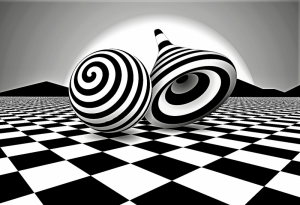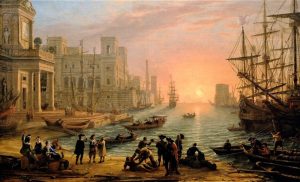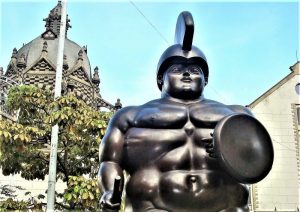Op art
An optical illusion represents our sense of vision and perception to define a reality in different ways. Op art or Optical art is based on the fact that the observer actively participates in pictorial appreciation through visual effects of relief, depth, movements through lines, flat and static colors.
What is op art?
Op art is a trend developed from the kinetic art that appeared after surrealism in the 20th century. It is defined as an artistic movement originating in the United States in 1958, which uses optical phenomena to produce abstract pictorial images, is considered an innovation by the use of illusory elements for the eye of the viewer.
About op art
This type of art creates sensations of movement through optical illusions on two-dimensional surfaces, developing perspectives that the human eye cannot fix in space.
Characteristics
The most outstanding characteristics of op art are:
- It uses simple geometric figures that combined form more complex figures.
- All the works made are physically immobile, that is to say, it lacks any real movement.
- Its main objective is to conceive several visual effects that simulate that they have movement.
- It is a technical and impersonal
- It has a scientific base with the objective of creating unique visual effects.
- It uses the repetition of simple forms of lines, cubes and concentric circles, in which black and white predominate and complementary colors contrast.
- It has defined and clean bases by using the technique of acrylic paintings.
- The works have an effect of depth.
- Thanks to the optical effects, a total dynamism is created in flat surfaces that before the human eye is transformed into three-dimensional spaces full of vibration, movement and oscillation.
- The artists use colors, light and shadows with great skill to create their works.
- They use optical techniques such as parallel lines, they can be undulating or straight and they have marked chromatic contrasts that can be bi-chromatic or polys.
Origin
Its origin is developed by the Hungarian artist Victor Vasarely (1906-1997) considered the father of Op art; Vasarely created his own model of geometric abstract art with optical effects of movement, ambiguity of forms, perspectives and unstable images. One of his most outstanding works was Zebra, an art style of the animal painting genre developed in Paris in 1937 when he was 31 years old.
History
Op art is an artistic pictorial movement and a trend born in April 1958 in the United States, although this school precedes in Europe where the first experiences on the perception of static or moving images lived; its main point of development and massification was in the United States.
It developed in the twentieth century, a period where world wars dominated and new nuclear weapons appeared, with the imminent arrival of the Cold War for the United States at that time.
Its terminology first appeared in Time magazine in October 1964.
It was influenced by movements such as Constructivism, Bauhaus, De Stijl and Supremacism.
Because of its variety of forms, op art was accepted by the public, where it had great influence in other areas of art such as advertising, graphics and fashion.
The movement was solidified by an exhibition held in 1965 at the Museum of Modern Art in New York entitled “The responsive, eye”.
Types of op art
Its most relevant derivations are:
- Abstract art: it is a manifestation of non-objective artistic beauty, where the artist does not copy the nature of forms but represents the authenticity of his art with a surrealist profile.
- Geometric abstract art: it is a style of artistic expression that refers to the use of simple geometric forms creating a subjectivity through compositions in surreal spaces.
- Kinetic art: contemporary art based on producing optical illusions through the creation of objects that change with real or virtual movements.
- Luminous Kinetic Art: Art that uses as a component of the work the introduction of real movements with a focus on artistic matter in spaces, light and time.
How it differs from kinetic art
- It lacks any real movement, that is to say, each work carried out is physically immobile due to its design of static works.
- Op art is a pictorial movement while kinetic art is an art based on sculpture.
Prestigious representatives of op art
- Victor Vasarely (1906-1997)
- Bridget Riley (1931-)
- Yaacov Agam (1928-)
- Jesús Rafael Soto (1923-2005)
- Carlos Cruz Diez (1923-)
- Youri Messen Yashin (1941-)
- Julio Le Parc (1928-)
- Reuven Ruby (1893-1974)
- Kenneth Noland (1924-2010)
- Richard Anuszkiewicz (1930-)
- Jean Pierre Yvaral (1934-2002)
- Escher (1898-1962)
Works
The most outstanding works of op art are:
- Zebra (Victor Vasarely 1937)
- Tigers (Victor Vasarely 1938)
- Circle limit III (M. C. Escher 1959)
- Air and water (M. C. Escher 1938)
- Liberation (M. C. Escher 1955)
- Movement in squares (Bridget Riley 1961)
- Blaze 1 (Bridget Riley 1962)
Importance
This movement generates a constant evolution in the modern world and in art, since constantly the perception, culture, beliefs, concepts and ideals are modified over time through the contribution of manifestations that definitively create a synergy between the spectator and the work. Therefore, this movement lacks emotions for greater receptivity and interpretation, only using techniques such as illusion.
How to cite this article?
Briceño V., Gabriela. (2019). Op art. Recovered on 23 February, 2024, de Euston96: https://www.euston96.com/en/op-art/










